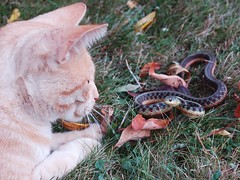Cats and snakes in the wild
Bob writes, “I just heard the debate on KQED’s Forum regarding the Sharp Park Golf Course. One of the speakers said that cats may be the principle killer of the [San Francisco Garter] Snake. Do you know if this is a valid statement and if so what is being done to stop the cats?”
Bob’s referring to the debate over Sharp Park, a golf course owned by the City of San Francisco (but is located in nearby Pacifica) that serves as habitat for the endangered San Francisco garter; I covered the story on Gartersnake.info here and here.
But he’s also talking about the impact that feral and domestic cats have on local wildife populations, which has been an increasing concern among conservationists. No matter how tame, cats are born hunters; if left outside, they will do what they do best. And with 100 million cats in the United States alone, that adds up to a lot of dead wildlife. From the fact sheet Facts on Cats and Wildlife: A Conservation Dilemma:
Although rural, free-ranging cats have greater access to wild animals and undoubtedly take the greatest toll, even urban house pets take live prey when allowed outside. Extensive studies of the feeding habits of free-ranging domestic cats over 50 years and four continents indicate that small mammals make up approximately 70 percent of these cats’ prey. Birds make up about 20 percent. The remaining 10 percent is a variety of other animals. The diets of free-ranging cat populations, however, reflect the food locally available.
Observation of free-ranging domestic cats shows that some individuals can kill over 1,000 wild animals per year, although smaller numbers are more typical. Some data suggest that free-ranging cats living in small towns kill an average of 14 wild animals each per year. Rural cats kill many more wild animals than urban or suburban cats do. Several studies found that up to 90 percent of free-ranging domestic cats’ diet was wild animals, and less than 10 percent of rural cats killed no wild animals.
See also the American Bird Conservancy’s fact sheet (PDF), which cites some specific, regional studies.
It’s a similar story in the U.K., where a study on cat predation estimated that approximately nine million British cats were catching something like 85 to 100 million wild animals a year — 52 to 63 million mammals, 25 to 29 million birds, and 4 to 6 million reptiles and amphibians. (This page disputes that study’s findings.)
The bottom line is that cats can kill an awful lot of small wild animals. Because they’re looked after by humans, they’re not subject to the same population pressures that wild predators are, which means that lots of cats can predate upon a given wildlife population. In other words, high cat population densities lead to low densities of wild animals.
Cat predation on birds get the most press, because birds have better P.R. No one gives a damn if a local population of meadow voles gets exterminated, but we generally want birds around — especially the small songbirds that make people go “AW!” and cats go “NOM!”
But cats also bring home frogs, toads and lizards — and they certainly bring home snakes. A friend of mine was once handed a Brown Snake (Storeria dekayi) that was brought home by a neighbourhood cat. Think about it: to a cat, a snake is basically a string that moves of its own accord. How can a cat resist that? But the cat may play with a snake it’s caught without killing it outright, giving it a chance at actually surviving if the cat’s people show up in time.
Our own cats have been absolutely transfixed by our snakes, at least while they were young. Fortunately, after a few years of daily exposure, the cats grew out of it. Without that kind of constant exposure, I can’t see a cat ever getting blasé about encountering a snake. I do know of one situation where a cat-and-snake owner brought a snake face-to-face with the cat; the snake promptly bit the cat on the nose, after which the cat was not at all interested in snakes. I wouldn’t recommend that kind of treatment.
Cats aren’t the only threat to wild snake populations, and humans certainly have done plenty of other things to put snakes (to say nothing of other animals) at risk, but keeping your cat indoors — particularly if you’re in a rural or suburban area where your cat might actually encounter wildlife — is one of the best things you can do on behalf of snake conservation.
Photos by Peter (pl1602), David (chickenboots) and Robert Huffstutter used in accordance with their Creative Commons licences.


